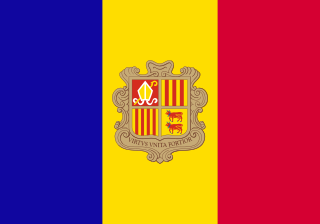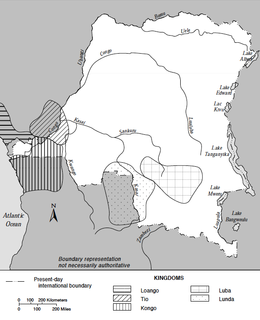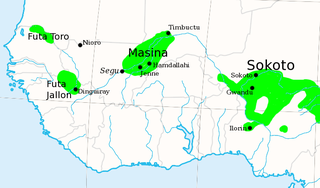Sovereign states
A


- Annam – Empire of Annam
- Anziku – Anziku Kingdom






Andorra, officially the Principality of Andorra, also called the Principality of the Valleys of Andorra, is a sovereign landlocked microstate on the Iberian Peninsula, in the eastern Pyrenees, bordering France to the north and Spain to the south. Believed to have been created by Charlemagne, Andorra was ruled by the Count of Urgell until 988, when it was transferred to the Roman Catholic Diocese of Urgell, and the present principality was formed by a charter in 1278. It is known as a principality as it is a diarchy headed by two Princes: the Catholic Bishop of Urgell in Catalonia, Spain, and the President of France.

Ankole, was a traditional Bantu kingdom in Uganda. The kingdom is located in south-western Uganda, east of Lake Edward. It was ruled by a monarch known as the Mugabe or Omugabe. The kingdom was formally abolished in 1967 by the government of President Milton Obote, and since then, the kingdom has not been restored officially. The people of Ankole are called Banyankole in Runyankole language, a Bantu language.

The Anziku Kingdom, also called the Teke Kingdom, the Tyo Kingdom or Tio Kingdom, was a pre-colonial West Central African state of modern Republic of Congo.
B

- Baguirmi – Kingdom of Baguirmi
- Baol – Kingdom of Baol



- Bhutan – Kingdom of Bhutan


- Bornu – Bornu Empire






- Burundi – Kingdom of Burundi

The Grand Duchy of Baden was a state in the southwest German Empire on the east bank of the Rhine. It existed between 1806 and 1918.
The Kingdom of Baol or Bawol in central Senegal was one of the kingdoms that arose from the split-up of the Empire of Jolof (Diolof) in 1555. The ruler reigned from a capital in Diourbel.

The Kingdom of Bavaria was a German state that succeeded the former Electorate of Bavaria in 1805 and continued to exist until 1918. The Bavarian Elector Maximilian IV Joseph of the House of Wittelsbach became the first King of Bavaria in 1805 as Maximilian I Joseph. The crown would go on being held by the Wittelsbachs until the kingdom came to an end in 1918. Most of Bavaria's present-day borders were established after 1814 with the Treaty of Paris, in which Bavaria ceded Tyrol and Vorarlberg to the Austrian Empire while receiving Aschaffenburg and Würzburg. With the unification of Germany into the German Empire in 1871, the kingdom became a federal state of the new Empire and was second in size, power, and wealth only to the leading state, the Kingdom of Prussia. In 1918, Bavaria became a republic, and the kingdom was thus succeeded by the current Free State of Bavaria.
C

- Cayor – Kingdom of Cayor




Canada is a country in the northern part of North America. Its ten provinces and three territories extend from the Atlantic to the Pacific and northward into the Arctic Ocean, covering 9.98 million square kilometres, making it the world's second-largest country by total area. Canada's southern border with the United States, stretching some 8,891 kilometres (5,525 mi), is the world's longest bi-national land border. Its capital is Ottawa, and its three largest metropolitan areas are Toronto, Montreal, and Vancouver. As a whole, Canada is sparsely populated, the majority of its land area being dominated by forest and tundra. Consequently, its population is highly urbanized, with over 80 percent of its inhabitants concentrated in large and medium-sized cities, with 70% of citizens residing within 100 kilometres (62 mi) of the southern border. Canada's climate varies widely across its vast area, ranging from arctic weather in the north, to hot summers in the southern regions, with four distinct seasons.

Cayor was the largest and most powerful kingdom (1549–1879) that split off from the Jolof Empire in what is now Senegal. Cayor was located in northern and central Senegal, southeast of Walo, west of the kingdom of Jolof, and north of Baol and the Kingdom of Sine.

Chile, officially the Republic of Chile, is a South American country occupying a long, narrow strip of land between the Andes to the east and the Pacific Ocean to the west. It borders Peru to the north, Bolivia to the northeast, Argentina to the east, and the Drake Passage in the far south. Chilean territory includes the Pacific islands of Juan Fernández, Salas y Gómez, Desventuradas, and Easter Island in Oceania. Chile also claims about 1,250,000 square kilometres (480,000 sq mi) of Antarctica, although all claims are suspended under the Antarctic Treaty.
Cook Islands ![]()
Contents
- Sovereign states
- A
- B
- C
- D
- E
- F
- G
- H
- I
- J
- K
- L
- M
- N
- O
- P
- R
- S
- T
- U
- V
- W
- Y
- Z
- Non-sovereign territories
- United Kingdom
- States claiming sovereignty

D
- Dahomey – Kingdom of Dahomey



The Kingdom of Dahomey was an African kingdom that existed from about 1600 until 1894, when the last king, Béhanzin, was defeated by the French, and the country was annexed into the French colonial empire. Dahomey developed on the Abomey Plateau amongst the Fon people in the early 17th century and became a regional power in the 18th century by conquering key cities on the Atlantic coast.

Denmark, officially the Kingdom of Denmark, is a Nordic country and the southernmost of the Scandinavian nations. Denmark lies southwest of Sweden and south of Norway, and is bordered to the south by Germany. The Kingdom of Denmark also comprises two autonomous constituent countries in the North Atlantic Ocean: the Faroe Islands and Greenland. Denmark proper consists of a peninsula, Jutland, and an archipelago of 443 named islands, with the largest being Zealand, Funen and the North Jutlandic Island. The islands are characterised by flat, arable land and sandy coasts, low elevation and a temperate climate. Denmark has a total area of 42,924 km2 (16,573 sq mi), land area of 42,394 km2 (16,368 sq mi), and the total area including Greenland and the Faroe Islands is 2,210,579 km2 (853,509 sq mi), and a population of 5.8 million.

The Dominican Republic is a country located in the island of Hispaniola, in the Greater Antilles archipelago of the Caribbean region. It occupies the eastern five-eighths of the island, which it shares with the nation of Haiti, making Hispaniola one of two Caribbean islands, along with Saint Martin, that are shared by two sovereign states. The Dominican Republic is the second-largest Caribbean nation by area at 48,671 square kilometers (18,792 sq mi), and third by population with approximately 10 million people, of which approximately three million live in the metropolitan area of Santo Domingo, the capital city.
E





Ecuador, officially the Republic of Ecuador, is a country in northwestern South America, bordered by Colombia on the north, Peru on the east and south, and the Pacific Ocean on the west. Ecuador also includes the Galápagos Islands in the Pacific, about 1,000 kilometres (620 mi) west of the mainland. The capital city is Quito, which is also the largest city.

El Salvador, officially the Republic of El Salvador, is the smallest and the most densely populated country in Central America. It is bordered on the northeast by Honduras, on the northwest by Guatemala, and on the south by the Pacific Ocean. El Salvador's capital and largest city is San Salvador. As of 2016, the country had a population of approximately 6.34 million.

The Ethiopian Empire, also known as Abyssinia, was a kingdom that spanned a geographical area in the current states of Eritrea and Ethiopia. It began with the establishment of the Solomonic dynasty from approximately 1270 and lasted until 1974, when the ruling Solomonic dynasty was overthrown in a coup d'état by the Derg.
F
- Fante – Fante Confederacy
- Fiji – Kingdom of Fiji
- Futa Jallon – Imamate of Fouta Djallon
- Futa Toro – Imamate of Futa Toro

The Fante Confederacy can refer either to the loose alliance of the Fante states in existence at least since the sixteenth century, or it can refer to the short-lived Confederation formed in 1868 and dissolved in 1874. The Confederation is seen as one of the first self-rule movements in Africa.

Fiji, officially the Republic of Fiji, is an island country in Melanesia, part of Oceania in the South Pacific Ocean about 1,100 nautical miles northeast of New Zealand's North Island. Its closest neighbours are Vanuatu to the west, New Caledonia to the southwest, New Zealand's Kermadec Islands to the southeast, Tonga to the east, the Samoas and France's Wallis and Futuna to the northeast, and Tuvalu to the north. Fiji consists of an archipelago of more than 330 islands—of which 110 are permanently inhabited—and more than 500 islets, amounting to a total land area of about 18,300 square kilometres (7,100 sq mi). The most outlying island is Ono-i-Lau. The two major islands, Viti Levu and Vanua Levu, account for 87% of the total population of 898,760. The capital, Suva, on Viti Levu, serves as the country's principal cruise-ship port. About three-quarters of Fijians live on Viti Levu's coasts, either in Suva or in smaller urban centres such as Nadi—where tourism is the major local industry—or Lautoka, where the sugar-cane industry is paramount. Due to its terrain, the interior of Viti Levu is sparsely inhabited.

The Imamate of Futa Jallon or Jalon was a West African theocratic state based in the Fouta Djallon highlands of modern Guinea. The state was founded around 1727 by a Fulani jihad and became part of the French Third Republic's colonial empire in 1896.
G
H
I

J
K
- Kabulistan – Kingdom of Kabul
- Kaffa – Kingdom of Kaffa

- Kénédougou – Kénédougou Kingdom
- Khasso – Kingdom of Khasso

- Kokand – Khanate of Kokand
- Kong – Kong Empire


- Koya Temne – Kingdom of Koya
L


- Limmu-Ennarea – Kingdom of Limmu-Ennarea
- Loango – Kingdom of Loango
- Luba – Luba Empire
- Lunda – Lunda Empire

M

- Manipur – Kingdom of Manipur
- Matabeleland – Matabele Kingdom





N






O


- Ouaddai – Ouaddai Empire
- Oyo – Oyo Empire
P
R
S
- Samoa – Kingdom of Samoa





- Sikkim – Chogyalate of Sikkim

South African Republic ![]()




T

- Tonga – Kingdom of Tonga

- Toucouleur – Toucouleur Empire

U



V

W
- Welayta – Kingdom of Welayta

Y
- Yeke – Yeke Kingdom